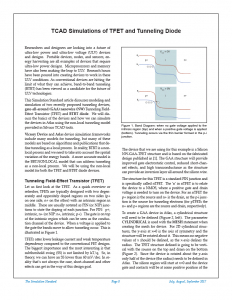TCAD Simulations of TFET and Tunneling Diode
Researchers and designers are looking into a future of ultra-low power and ultra-low voltage (ULV) devices and designs. Portable devices, nodes, and sensors, energy harvesting are all examples of devices that require ultra-low power designs. Microprocessors and memory have also been making the leap to ULV. Research hours have been poured into creating devices to work in these ULV conditions. As conventional devices are hitting the limit of what they can achieve, band-to-band tunneling (BTBT) has been viewed as a candidate for the future of ULV technologies.
This Simulation Standard article discusses modeling and simulation of two recently proposed tunneling devices, gate-all-around (GAA) nanowire (NW) Tunneling Field-Effect Transistor (TFET) and BTBT diode. We will discuss the basics of the devices and how we can simulate the devices in Atlas using the non-local tunneling model provided in Silvaco TCAD tools.
Victory Device and Atlas device simulation frameworks include many models for tunneling, but many of these models are based on algorithms and publications that define tunneling as a local process. In reality, BTBT is a non-local process and we need to take into account the spatial variation of the energy bands. A more accurate model is the BBT.NONLOCAL model that can address tunneling as a non-local process. We will be using the non-local model for both the TFET and BTBT diode devices.



